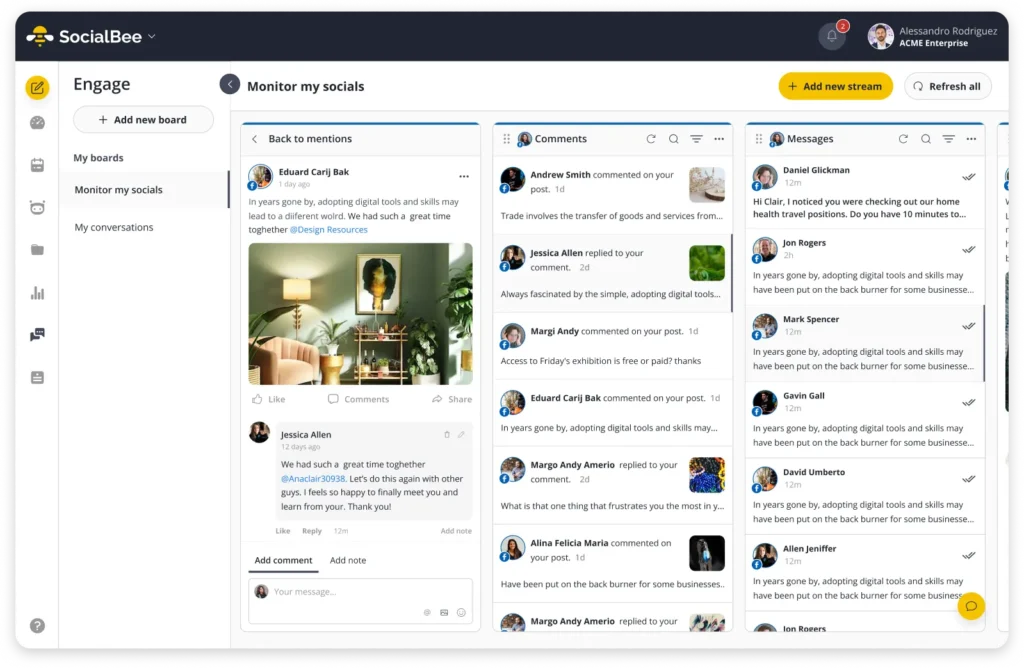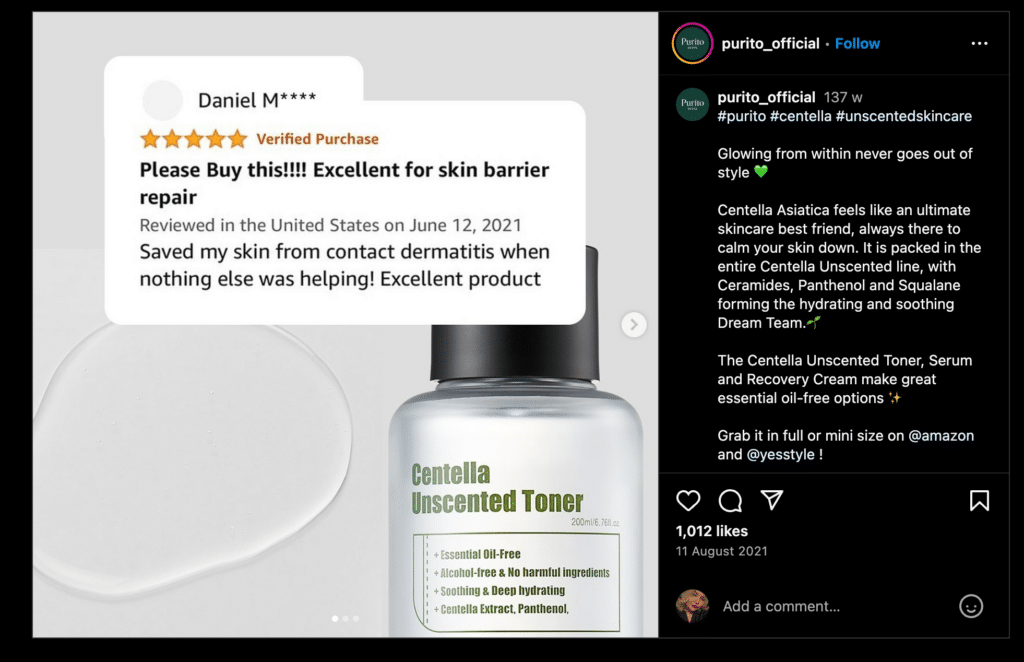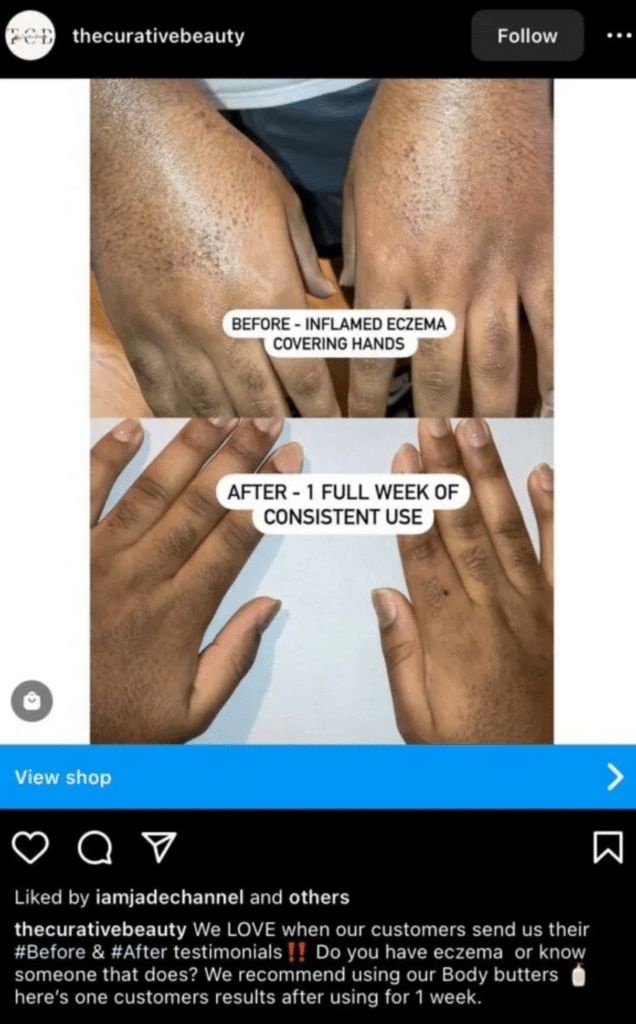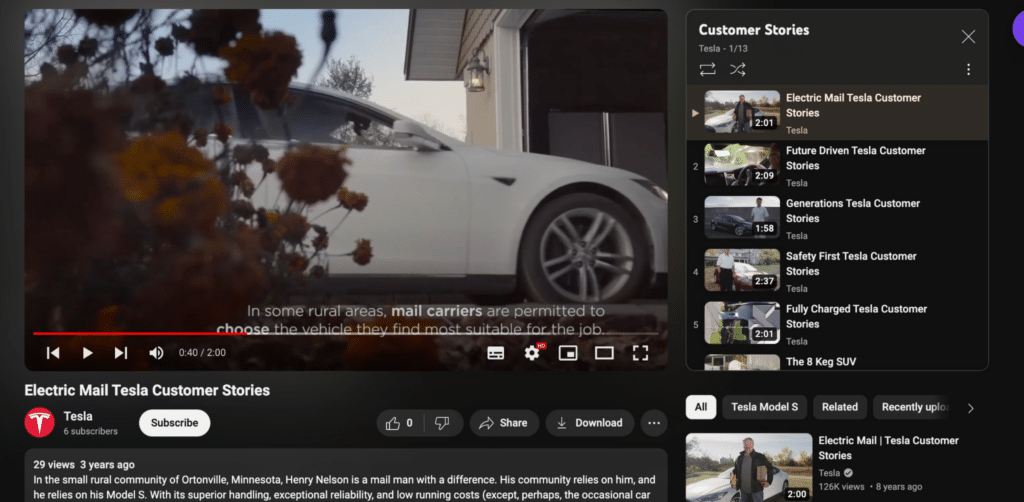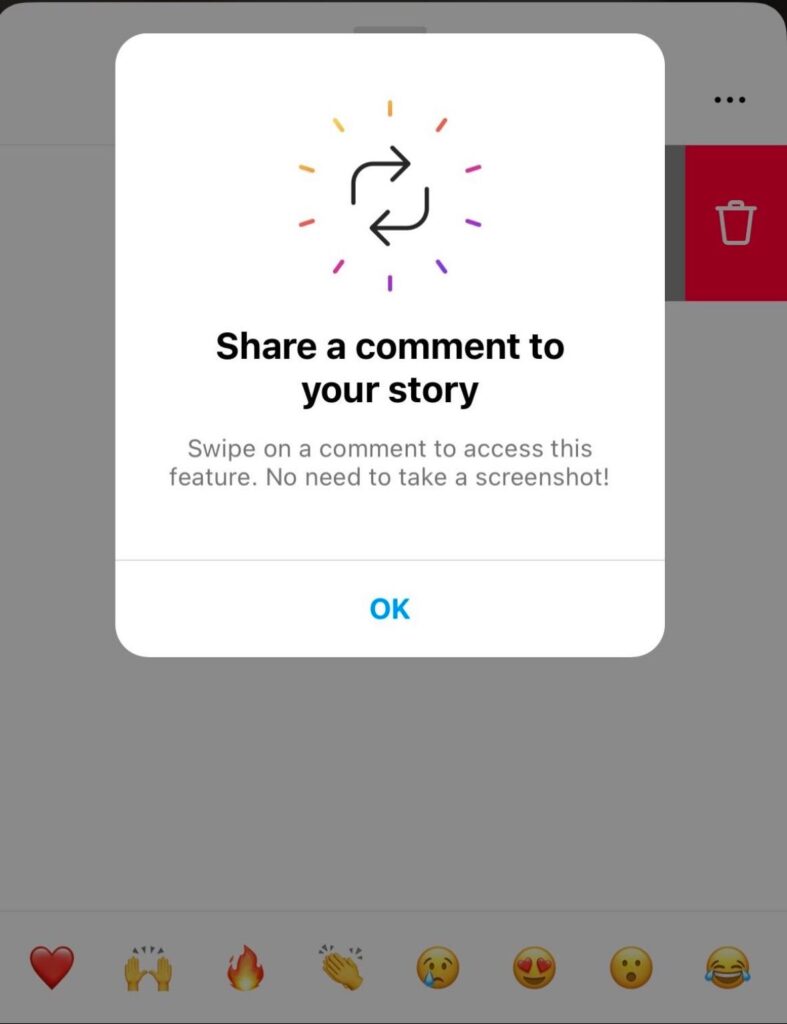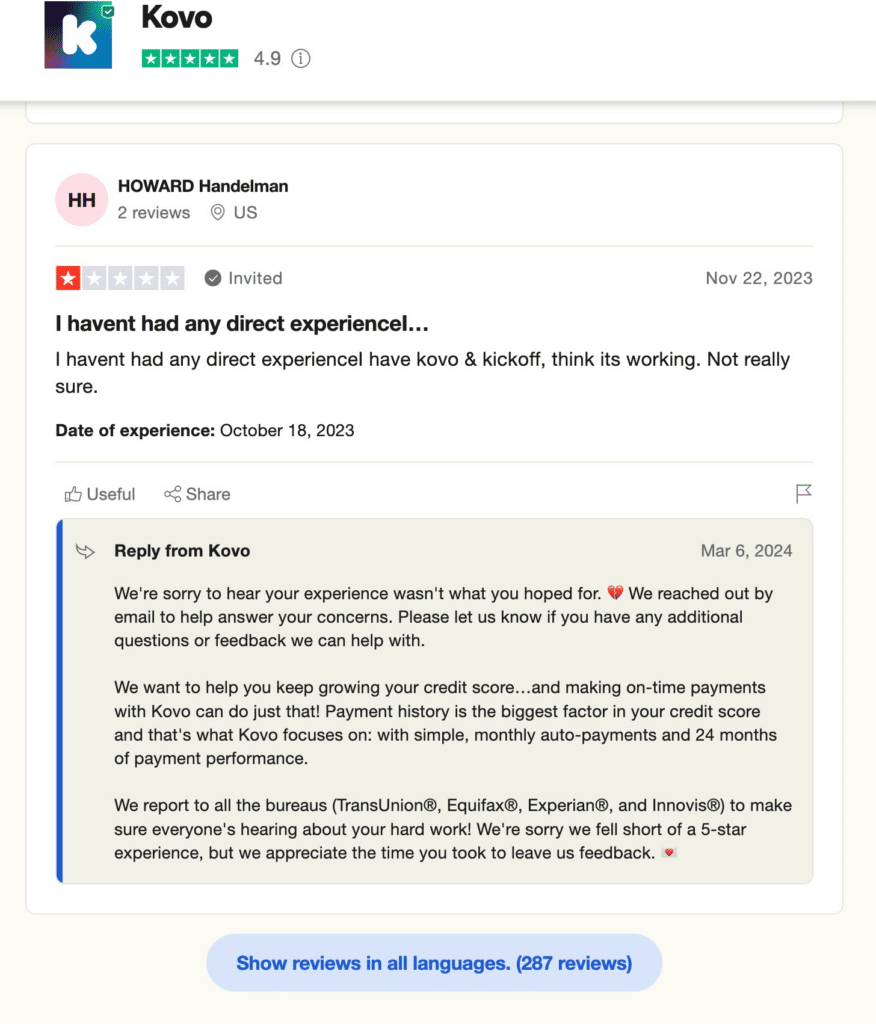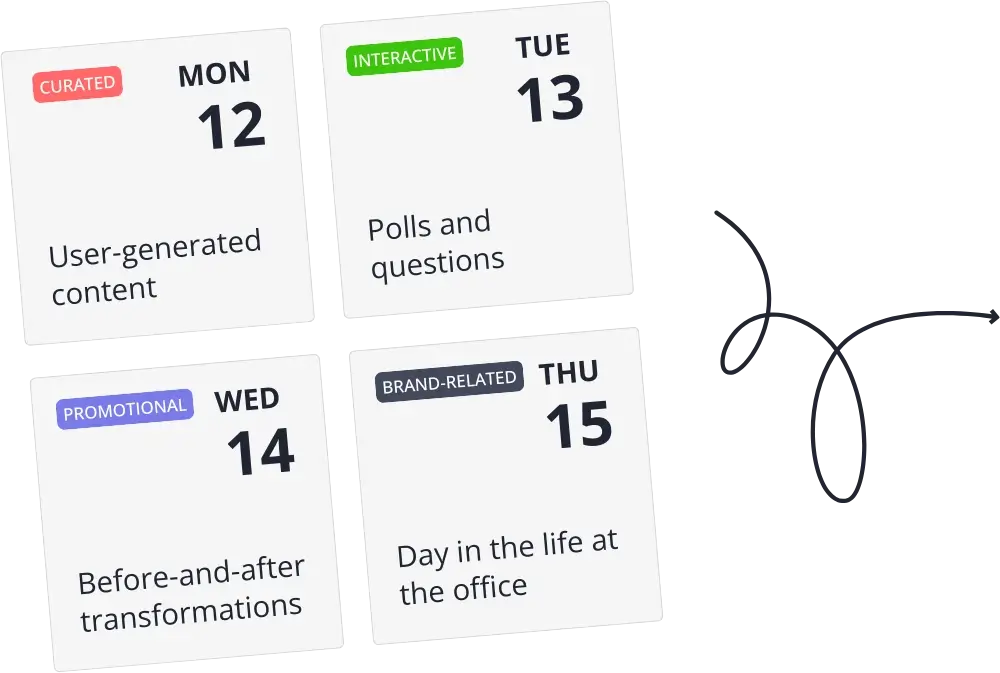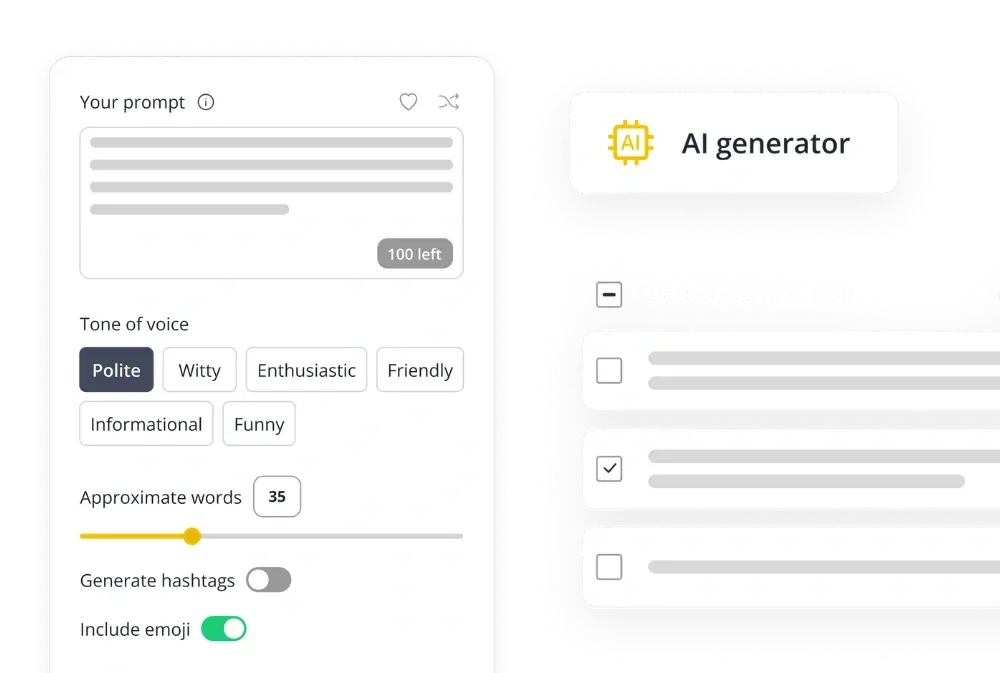
Guest Author
Social media reviews and testimonials are crucial for the growth and sustainability of e-commerce brands.
These insights not only provide valuable feedback but also serve as a testament to your brand’s reliability and customer satisfaction. Leveraging these can significantly enhance your brand’s visibility and trust among potential customers, setting the foundation for a successful online presence.
Let’s dive into how you can effectively use social media reviews and testimonials to elevate your e-commerce brand.
We’re SocialBee LABS SRL, part of WebPros. We use the information you provide to share relevant content and product updates, as outlined in our Privacy Policy. You can opt out anytime.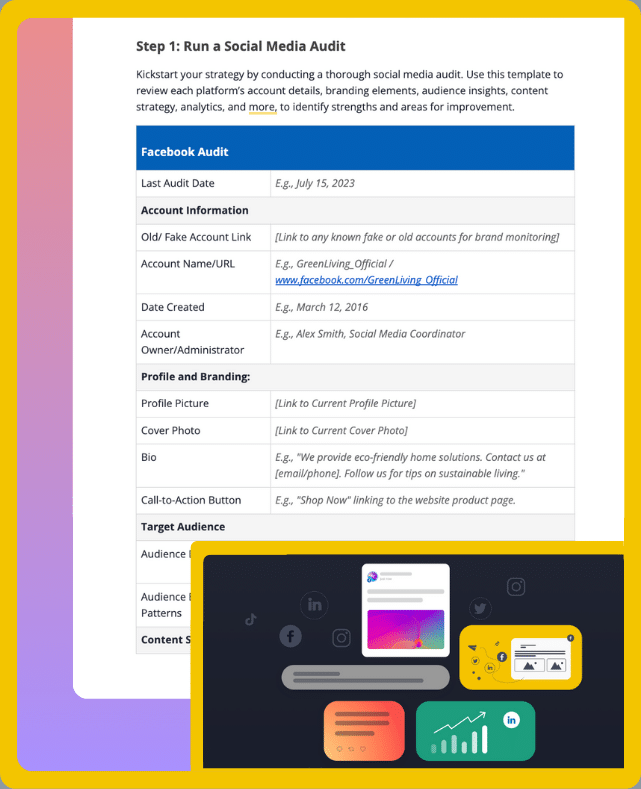
Short Summary
- Social media helps you connect with customers worldwide, get real feedback, and even save on marketing costs.
- Customer reviews and testimonials on social media are your digital word-of-mouth, showcasing real customer experiences that draw in new buyers, build trust, and enhance your reputation.
- There’s a subtle but important difference between reviews and testimonials. Reviews are informal opinions found on external sites, offering a wide range of customer experiences. Testimonials are the positive feedback you pick to show off on your site. Both are important, but they serve different purposes.
- To gather positive social media feedback, ask clearly, offer rewards, simplify the process, and personalize interactions. This approach encourages sharing and strengthens connections with your audience.
- Dealing with feedback—good or bad—is crucial. Respond quickly and thoughtfully to show you care. This can turn a bad review into a chance to show just how much you value customer satisfaction.
Table of Contents
- What’s the Difference Between Reviews and Testimonials?
- Why You Need Both in Your Social Media Strategy
- How Can You Get More Reviews and Testimonials?
- Types of Social Media Reviews and Testimonials
- How to Tackle Negative Reviews on Social Media Platforms
- Social Proof, Internal Efficiency, and Positive Reviews
- Frequently Asked Questions
- Leverage Reviews and Testimonials for Social Media Growth
What’s the Difference Between Reviews and Testimonials?
Testimonials are chosen endorsements used by businesses to show customer satisfaction and enhance their image. Reviews, however, are unrequested and can be positive or negative, appearing on third-party sites to give a transparent, broad view of customer experiences.
This difference highlights the controlled, promotional nature of testimonials versus the spontaneous, diverse nature of reviews, each serving specific roles in building a brand’s reputation and trustworthiness.
Let us walk you through the main differences between social media reviews and testimonials:
- Social Media Reviews
- Customer Testimonials
Let’s sum up the differences between reviews and testimonials:
|
1. Social Media Reviews
Social media reviews are key to an e-commerce brand’s reputation, acting as digital word-of-mouth that influences customer choices by sharing experiences widely online.
Here are some key features of social media reviews:
- Platforms and impartiality
- Third-party platforms: Reviews are typically found on platforms such as Yelp, Google Business Profile, and social media sites like Facebook.
- Impartiality: These platforms are not controlled by the businesses being reviewed, lending credibility and a sense of impartiality to the reviews posted.
- Transparency and authenticity
- Public and unfiltered: Reviews are publicly accessible, showcasing genuine customer opinions ranging from highly positive to negative.
- Authentic customer experiences: This transparency allows potential customers to gain insights into real experiences, aiding in their decision-making process.
- Impact on reputation and business
- User-generated content: Reviews constitute direct feedback from customers, influencing a business’s online reputation.
- Influence on potential customers: Positive reviews can attract new customers, while negative feedback provides valuable insights for improvement.
- Specific advantages for local businesses
- Critical for local SEO: A robust profile of positive reviews on Google Business Profile can improve a business’s visibility in local search results.
- Driving customer decisions: Consumers often rely on reviews when choosing local services or businesses, making them a key factor in driving foot traffic and sales.
Understanding the dynamics of social media reviews is essential for businesses aiming to maintain a positive online presence and leverage the power of digital word-of-mouth.
By actively engaging with customer feedback and managing their online reputation, businesses can harness the potential of social media reviews to attract new customers, improve their offerings, and ultimately drive success.
2. Customer Testimonials
Customer testimonials serve as a potent form of social proof, where businesses showcase the positive experiences of satisfied customers to reinforce their credibility and attract potential customers.
Unlike the broad spectrum of user reviews found on third-party platforms, testimonials are directly solicited and curated by the business, offering a controlled narrative that highlights the best of what the company has to offer.
Here are the key characteristics of customer testimonials:
- Nature and collection
- Direct feedback to the company: Testimonials are collected directly from customers, often through solicitation by the business.
- Highlighting positive experiences: They specifically focus on positive feedback, serving as endorsements of the company’s products or services.
- Role as a marketing asset
- Powerful promotional tool: Testimonials are used prominently in marketing materials to build trust and credibility among potential customers.
- Strategic showcase: By featuring satisfied customers, testimonials act as evidence of the company’s ability to deliver satisfaction and quality.
- Control and curation
- Business-controlled content: The company has full control over which testimonials are displayed and how they are presented.
- Curated presentation: This allows for a strategic approach to how customer feedback is showcased, ensuring that only the most favorable testimonials are made public.
- Comparison with reviews
- Contrast with traditional review sites: Unlike the user-generated content on review sites, testimonials are selectively gathered and presented by the business. You can even choose to present customer testimonials on your website.
- Polished presentation: This controlled and curated approach means testimonials can be made to appear more polished and intentional, contrasting with the more spontaneous nature of online reviews.
Here’s how LotusBelle chose to showcase their testimonials on their website:
This is a great example of testimonial showcasing because:
- They addressed concerns with testimonials for more credibility
- They showcased celebrity testimonials
- They leveraged user-generated content.
For a growth-oriented e-commerce company, gathering as many positive reviews and testimonials as possible is essential for everything we’ll talk about next.
This is the type of content that will persuade potential customers to buy from you, and it’s the type of content you can leverage to bring old customers back.
Why You Need Both Reviews and Testimonials in Your Social Media Strategy
You might think that reviews are easier to collect than testimonials, and that reviews alone are enough to build your reputation on social media and beyond.
In reality, however, you should really leverage both for maximum social proof, engagement, and marketing potential in general.
Reviews and testimonials work together to capture the attention of your audience, spark conversations, tell a story about your e-commerce store, and help you push individual products as well as your brand as a whole.
Let’s take a look at why you might need social media reviews and customer testimonials:
A. Why Do You Need Social Media Reviews
Social media reviews are indispensable for businesses looking to enhance their online presence and engage effectively with their audience.
Online consumers in the United States anticipate seeing a substantial volume of reviews for products viewed online – on average, they expect to find 112 reviews, with younger buyers looking for more reviews compared to their older counterparts.
Here’s why you need social reviews:
- Capturing the audience’s attention: In a crowded digital landscape, glowing reviews on social media can immediately grab the attention of potential customers.
- Analyzing the brand at a glance: Reviews provide a quick snapshot of the brand’s reputation, allowing consumers to assess the quality and reliability of your products or services instantly.
- Ensuring a favorable first impression: Positive social media reviews can shape a favorable first impression, significantly influencing potential customers’ perception of your brand.
- Positioning as a local business: For local businesses, positive reviews can enhance your standing in the community, making you the go-to choice for local customers.
- Gathering customer feedback at scale: Social media reviews offer a way to collect feedback from a wide audience, providing valuable insights into customer preferences and areas for improvement that can be later added to your knowledge management tools.
- Engaging with new customers: Much like social media comments and mentions, reviews open a channel for engagement, inviting new customers to interact with your brand based on the positive experiences of others.
Manage comments, mentions, & DMs easily with SocialBee!
SocialBee is an AI-powered social media management tool that allows users to create, publish, analyze, engage, collaborate, and streamline their social media posting, but can also help you with monitoring.
SocialBee’s Social Media Engagement dashboard streamlines social media interactions into a single dashboard, allowing brands to:
- Understand how followers feel about them
- Get feedback and learn how to improve
- Address questions and concerns quickly to show care
- Discover social media mentions that can be further used as testimonials.
Use SocialBee’s Social Inbox for a cohesive approach to social media.

Monitor Your Social Media Interactions with SocialBee!
B. Why Do You Need Customer Testimonials
Customer testimonials play a crucial role in building a business’s reputation and can significantly enhance its marketing efforts.
Here’s a concise breakdown of why testimonials are indispensable:
- Gathering personalized feedback: Testimonials provide deep insights into individual customer experiences, offering a level of detail that can guide improvements and innovations.
- Showcasing the best customer experiences: By highlighting the most positive experiences, testimonials serve as powerful evidence of your company’s ability to satisfy customers.
- Building brand reputation across platforms: Testimonials can be shared across various platforms, including social media or your website, to create a cohesive and positive brand image.
How Can You Get More Reviews and Testimonials?
Let’s address the question that everyone wants answered–how do you get more reviews and how do you create more testimonials?
- How to get more social media reviews
- How to get more customer testimonials
1. How to Get More Social Media Reviews
Boosting your collection of positive social media reviews can significantly enhance your online presence and reputation.
Achieving this involves directly engaging with customers, offering incentives for their feedback, and simplifying the review process using methods like embedded forms or QR codes which can be easily created by utilizing a QR Code Generator.
Here’s how you can collect social media reviews:
- Incorporate effective calls to action (CTAs): Encourage customers to leave a review after every interaction by using strong CTAs. Asking directly can significantly increase your chances of receiving reviews.
- Offer valuable incentives: Motivate customers by providing rewards for leaving reviews, such as discounts, small gifts, or store credits, to encourage positive feedback.
- Streamline the review process: Simplify the process for customers to leave reviews by minimizing the steps involved. Utilize QR codes and embed review forms in emails to make it as easy as possible.
- Utilize compelling content: Make your review requests more engaging with attractive visuals and persuasive writing. Effective content can motivate customers to share their experiences.
- Claim your business on review platforms: Ensure your business is present and your accounts are claimed on all relevant review sites and social media platforms, broadening the channels for receiving reviews.
- Leverage net promoter score (NPS) surveys: Use NPS surveys to identify highly satisfied customers and reach out to them specifically for reviews, as they are more likely to share positive experiences.
- Run targeted email campaigns: Send personalized emails to recent customers asking for reviews. Tailoring these messages can improve response rates.
- Respond to all reviews: Make it a point to engage with and thank customers for their reviews, regardless of the sentiment. This demonstrates that you value all feedback and are committed to customer satisfaction.
- Approach customers at the right time: Optimal timing can increase the likelihood of receiving a review. Ask for feedback when the positive experience is fresh in the customer’s mind.
2. How to Get Customer Testimonials
We talked about how a testimonial is more personal and detailed, so it deserves a different approach altogether.
Testimonials are not something you want to create en masse, instead, you want to take your time to get in touch with a select number of customers and take a personalized approach.
This is your opportunity to create some stunning and impactful content that you will be able to share across social media, embed on your website and in your emails, and much more.
With that in mind, here are the steps to get customer testimonials:
- Find satisfied customers who have purchased several products from you and keep coming back.
- Reach out to them via email that is personalized and has a clear message.
- Tell them that you’d love to feature them in a testimonial and explain why this matters.
- Take the time to talk to the customer about what kind of testimonial it should be, and what they’d like to talk about.
- Engage your designers to turn the testimonial into different types of social media content–static posts, beautiful graphics, horizontal and vertical videos.
Here’s how ASOS shared a testimonial on their Instagram account:
This will be a dedicated project that will collect a smaller feedback sample, but this feedback will empower many of your future marketing and branding campaigns.
Types of Social Media Reviews and Testimonials
Lastly, what are some of the types of social media reviews and testimonials that you can use to boost your brand online and offline?
Know that you can gather direct feedback with an NPS survey, a customer satisfaction survey, and by making customer testimonials. At the same time, you can gather indirect feedback via online reviews, website feedback forms, social media posts and comments, and word-of-mouth listening.
To start, it’s important to understand that this is content like any other, and as such, it can work in any form across all your social media channels.
Here’s how you can showcase reviews and testimonials on social media:
- Quote graphics
- Video testimonials
- User-generated content (UGC)
- Influencer partnerships
- Before and after content
- Story highlights
- Carousel posts
- Review recap videos
- Highlighted comments
1. Quote Graphics
Transform positive reviews or testimonials into eye-catching graphics that align with your brand’s visual theme. These graphics are perfect for sharing across social media platforms like Instagram, Twitter, and Facebook.
Here’s an example of quote testimonial from Purito:
They catch the audience’s attention quickly and can be a straightforward way to highlight customer satisfaction.
2. Video Testimonials
Engage audiences with videos of customers sharing their product or service experiences.
Take a look at how Rainier Media shared a video testimonial on TikTok:
These testimonials can range from detailed case studies to quick clips, suitable for platforms like Instagram, Facebook, YouTube, and TikTok, offering a personal touch that text alone cannot achieve.
3. User-Generated Content (UGC)
Encourage your customers to share their own experiences using your product, tagging your brand.
Here’s how Cluse shared user-generated content on their Instagram account:
Reposting this content showcases real-life applications of your products, providing genuine social proof and building a community around your brand.
4. Influencer Partnerships
Collaborate with influencers who share your target audience to provide honest reviews of your products.
Here’s an example of influencer review:
This strategy leverages the influencers’ trust with their followers, extending your reach and enhancing credibility.
5. Before and After Content
Particularly effective in the beauty, fitness, and home improvement sectors, before and after photos or videos showcase the tangible results of using your products.
Here’s an example of before and after content from The Curative Beauty:
This visual proof can be incredibly persuasive, illustrating the real value you offer.
6. Story Highlights
Make use of Instagram and Facebook Stories for temporary content sharing, and save testimonials as Story Highlights for permanent visibility.
For example, Supply House has collected their reviews in an Instagram highlight:
This ensures that positive feedback is always accessible to profile visitors.
7. Carousel Posts
Leverage the carousel post feature on Instagram and Facebook to present a series of reviews or a comprehensive testimonial across multiple images or videos.
Here’s such an example of carousel testimonial from Brows by Milly:
This approach allows followers to engage with in-depth feedback in an interactive format.
8. Review Recap Videos
Create engaging videos compiling customer reviews and testimonials from a specific period.
Tesla has nicely curated multiple customer review videos in a YouTube playlist:
These recap videos serve as dynamic showcases of customer satisfaction, ideal for sharing on your social media platforms and website.
9. Highlighted Comments
On platforms like Instagram, highlight positive comments at the top of your posts.
You can only pin comments from your mobile device by swiping left on the comments, as shown below:
You also have the option to share a comment on your Story afterwards.
This simple technique directly showcases favorable feedback, ensuring that it’s the first thing new visitors see when engaging with your content.
How to Tackle Negative Reviews on Social Media Platforms
Tackling negative reviews on social media platforms requires a thoughtful and strategic approach to not only address the concerns raised but also to demonstrate your commitment to customer satisfaction.
Here’s how to manage your business’ negative reviews:
- Monitor social media reviews regularly: Keep a close watch on what customers are saying about your business on social media platforms with the help of monitoring tools. This proactive approach allows you to respond promptly to any negative feedback.
- Acknowledge and apologize: When you encounter a negative review, the first step is to acknowledge the customer’s experience and offer a sincere apology. This shows that you’re listening and that you care about their concerns.
- Provide a thoughtful response: Craft review responses that are personalized and address the specific issues raised by the customer. Avoid generic replies, as they can make customers feel unheard.
- Move the conversation to a private channel: If possible, invite the customer to continue the conversation through direct messages or other private channels. This allows for a more detailed discussion of their concerns and demonstrates a commitment to resolving the issue.
- Offer a solution: Where applicable, offer a solution to the problem the customer faced. This could be a refund, replacement, discount on future purchases, or another gesture that shows you’re willing to make things right.
- Learn from the feedback: Use negative reviews as an opportunity to improve your business operations and customer service. Analyzing patterns in feedback can help you identify areas for improvement.
- Follow up: After addressing the customer’s concerns, follow up with them to ensure they’re satisfied with the resolution. This follow-up can turn a negative experience into a positive one and may even prompt the customer to update or remove their negative review.
- Encourage positive reviews: Encourage satisfied customers to share their experiences by posting customer reviews. A higher volume of positive reviews can help mitigate the impact of negative ones.
- Train your team: Ensure your team is trained on how to handle negative reviews and customer complaints effectively. Having a consistent approach across your organization is key to maintaining a positive customer experience.
- Maintain a positive tone: Always keep your responses professional and positive, even in the face of criticism. How you handle negative feedback can influence public perception of your brand.
Take a look at how Kovo is replying to their negative feedback on Trustpilot:
By adopting these strategies, you can effectively manage negative reviews on social media platforms, turning potential challenges into opportunities for demonstrating excellent customer service and commitment to customer satisfaction.
Social Proof, Internal Efficiency, and Positive Reviews
Social proof means that people feel incentivized to follow in the footsteps of others. In other words, you know you have good social proof when new customers are buying because other people have bought from you as well–and they’re happy with their purchase.
To build social proof, you need to showcase positive reviews and compelling testimonials across your social media accounts, and of course, across your website.
Think of all the different things that matter to your customers when they’re considering buying from you:
- Are the products of good quality?
- Have others bought from you and are satisfied?
- Do you fulfill orders quickly?
- Do you offer secure payment?
- Do you provide shipment tracking?
- What’s your return policy?
- How’s your customer support?
You need to answer all of these questions in order to allay their concerns, and you do it with smart review dissemination.
Getting great reviews starts with slick internal processes. Efficient accounts payable helps keep customers and suppliers happy, boosting your social proof. Remember, happy experiences lead to positive reviews, building trust in your brand.
It’s a loop: solid operations mean good feedback, which we show off everywhere. Smooth money handling, like quick purchases and refunds, matters too. That’s where ACH payments come in, making transactions easier and ditching old-school methods.
In short, making everything run smoothly is crucial, especially with lots of orders and customers. It keeps the good vibes rolling.
Frequently Asked Questions
The top social media review sites across various industries include:
- Google Business Profile: Crucial for visibility in Google search results and Maps.
- Yelp: Widely used for local businesses, especially in food and service sectors.
- TripAdvisor: Key for travel, hospitality, and dining businesses.
- Facebook: Offers businesses a platform for reviews and recommendations on their page.
- Amazon Customer Reviews: Essential for e-commerce products.
- Trustpilot: A broad platform for online business reviews.
- Zomato: Focuses on restaurant and food service reviews.
Yes, asking for reviews on social media is beneficial as it enhances social proof, improves visibility, fosters trust with your audience, and increases engagement on your platforms.
Additionally, it provides valuable insights into customer experiences, helping you refine your offerings.
Responding to social media reviews effectively can be summarized into a few key steps.
Always thank the reviewer, personalize your response by addressing specific points they’ve made, and offer solutions for any concerns. For positive feedback, express your gratitude and encourage further engagement.
Keep responses professional, especially when handling criticism, and aim for prompt replies to show your business values its customers and their feedback.
Leverage Reviews and Testimonials for Social Media Growth
Without a doubt, generating as many positive reviews and showcasing as many positive testimonials for your brand via social media is one of the keys to success.
The way to do this is by maximizing engagement on all your platforms, kick-starting interesting conversations with your communities, and leveraging UGC to build social proof. You can do all of this with SocialBee’s intuitive social media management platform that streamlines your processes and allows you to monitor all your social channels.
Start your 14-day SocialBee trial and start building your e-commerce presence on every social media platform efficiently and effectively.

Monitor Your Social Media Interactions with SocialBee!
About the author: A seasoned writer and storyteller, Sara does her best to share her experience with the world and help brands and entrepreneurs find their voice. She loves the learning curve that comes with writing, so she gladly takes on new topics that will expand her own knowledge and expertise. The only thing Sara steers clear of? Anything resembling a comfort zone in life, as well as writing.


